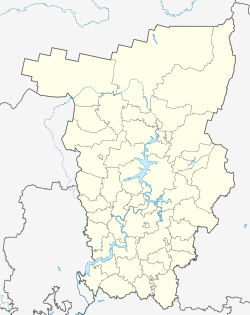Kujeda
| settlement
Kujeda
Куеда
|
||||||||||||||||||||||||||||||||||||
|
||||||||||||||||||||||||||||||||||||
|
||||||||||||||||||||||||||||||||||||
Kujeda ( Russian Куеда ) is a settlement (possjolok) in the Perm region in Russia with 9551 inhabitants (as of October 14, 2010).
geography
The place is just 180 km as the crow flies south of the Perm regional administration center in the western foothills of the Urals , about 30 km west-southwest of the city of Chernushka and almost directly on the border with the Republic of Bashkortostan . It is located not far from the left bank of the left Kama tributary Bui .
Kujeda is the administrative center of the Kujedinski Rajons and the seat of the rural municipality Kujedinskoje selskoje posselenije, which also includes the twelve villages of Arei, Badaschka, Garjuschka, Krasnoyar, Kujeda, Malaja Tapja, Manysch, Nikolskoye Rasdolje, Solodowka, Tregubowka and Urtalga without permanent residents 1279 km belong. The largest, each with over 400 inhabitants (as of 2010), are Kujeda (2 km northwest, the original village that is still independent today), Tregubowka (3 km north) and Urtalga (6 km west).
history
The settlement was established in 1914 in connection with the construction of the Kazan - Yekaterinburg railway line , after a station named after the nearby village was opened there. Due to the First World War there were delays in the completion of the route, and in the following Russian Civil War along the route to heavy fighting between the Red Army and the troops of Admiral Kolchak , which also severely destroyed the Kujeda station in 1918/1919. Regular operation on the continuous line began on July 1, 1920.
On 1924 Kujeda came to the newly formed Bikbardinki rajon, based in the village of Bikbarda, 10 km northeast . In 1931 the administration of the Rajon was relocated to Kujeda, which is now more important and more convenient in terms of transport, and the Rajon was renamed accordingly.
During the Second World War , various institutions from the western part of the Soviet Union were evacuated to Kujeda, including several children's homes from Leningrad and the Moscow Aviation Club, on the basis of which a flying school with several airfields in the area, including at Kujeda, was established.
From the 1950s, there was a further economic boom, in particular through the discovery and exploitation of oil deposits in the area, and on November 27, 1957, the Kujeda station settlement was given the status of an urban-type settlement . Since 1994 Kujeda has been classified as a rural settlement again.
Population development
| year | Residents |
|---|---|
| 1926 | 167 |
| 1939 | 2831 |
| 1959 | 5315 |
| 1970 | 7479 |
| 1979 | 8363 |
| 1989 | 9613 |
| 2002 | 9809 |
| 2010 | 9551 |
Note: census data
traffic
Kujeda is located at kilometer 1271 of the Moscow - Kazan - Yekaterinburg railway , an electrified main line and alternative route of the Trans-Siberian Railway .
The Perm - Ufa regional road runs through the village , which was previously designated as the R315. The Kujeda - Chernushka section today bears the number 57K-0030. The 57K-0017 branches off to the north, which as a shorter alternative route reaches the former R315 at the neighboring district center of Barda to the north, and in a north-westerly direction 57K-1812 to Bolshaya Ussa at 57K-0005 Tchaikovsky - Jelowo - Ossa .
Sons and daughters of the place
- Jelena Nurgalijewa (* 1976), athlete
- Olesja Nurgalijewa (* 1976), track and field athlete
Web links
Individual evidence
- ↑ a b Itogi Vserossijskoj perepisi naselenija 2010 goda. Tom 1. Čislennostʹ i razmeščenie naselenija (Results of the All-Russian Census 2010. Volume 1. Number and distribution of the population). Tables 5 , pp. 12-209; 11 , pp. 312–979 (download from the website of the Federal Service for State Statistics of the Russian Federation)


